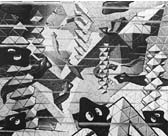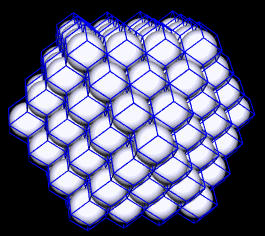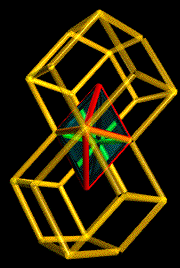Spheres of Relevance
| |
|
Fuller's alternative to the XYZ coordinate system
is artistically rendered by M.C. Escher in his lithograph Flatworms.[9]
Every move along one of its defining prime vectors is in alignment
with an edge of the regular, unit volume tetrahedron. These prime
vectors interconnect all the centers of adjacent unit-radius spheres
packing outward from a nuclear sphere in their cuboctahedral conformation.
|
 |
|
The unit-volume tetrahedron introduces simple whole
numbers in place of irrationals, thereby streamlining descriptions
that have hitherto relied on cubic units of mensuration. Cubes
are inherently less adept at "fitting in" as the primitives
of our spatial logic, despite their omnipresence in art and architecture.
Synergetics helps us identify the "hidden costs" associated
with our prejudice in favor of cubes and right angles as the most
"normal" or "rational" aspects of space, a
cultural bias by now deeply ingrained, but one which goes against
the grain of nature.
To take one example of a geometric description newly enhanced by synergetics, consider the space-filling rhombic dodecahedron, identified by mathematicians as the "Voronoi cell" for the face centered cubic lattice (see "the spheric" in Amy Edmondson's A Fuller Explanation).[10] This cell has a simple volume of six relative to the 4-sphere-defined tetrahedron (volume 1). When a Voronoi cell of volume six is divided into a sphere of volume 4.442882939 (4/3 pi times the third power of the synergetics constant), the result is the ratio of total volume to occupied volume, or lattice density.[11] The pre-synergetics sphere packers obtained the same lattice density of 0.740480489 using spheres and cells that were both irrationally volumed. |

|
|
Synergetics also provides us with the concept of
a "Coupler," the irregular octahedron defined by adjacent
sphere centers and their rhombic Voronoi cell interface. Couplers
also have unit volume in synergetics, and further analyze into
minimum space-filling tetrahedra (MITEs) of volume 1/8. MITEs
in turn disassemble into rationally volumed components (A and
B modules each of volume 1/24) which reassemble into tetrahedra
(volume one) and octahedra (volume four), space-filling complements
known as Delauney cells in the literature - cells which again
have awkwardly irrational volumes relative to the traditionally
unit-volumed cube with a unit-radius edge.
The question of whether 12 spheres around one really represents the densest possible packing has been a problem for mathematicians since it was first raised in discussions between Sir Isaac Newton and Oxford astronomer David Gregory in 1694. The jitterbug transformation, although not known by that name, is what kept the question open: when the 12 spheres around 1 shift into an icosahedral arrangement, but without contracting to squeeze out the nuclear sphere, they seem to almost leave enough room for a 13th sphere. Although the possibility of a 13th sphere was finally ruled out in a mathematical proof some 180 years later, the geometer H.S.M. Coxeter suggested in 1958 that perhaps the spare room might somehow accumulate in an irregular packing so as to permit an extra sphere at some point, and hence a denser arrangement. | |
| The possibility of a denser arrangement now appears about to be ruled out. Wu-Yi Hsiang, a professor at UCSB, has authored a 100 page proof, now being evaluated by mathematicians, that would show a density of .74 (or pi/root18) to indeed be the limiting case.[12] | |
|
| |
